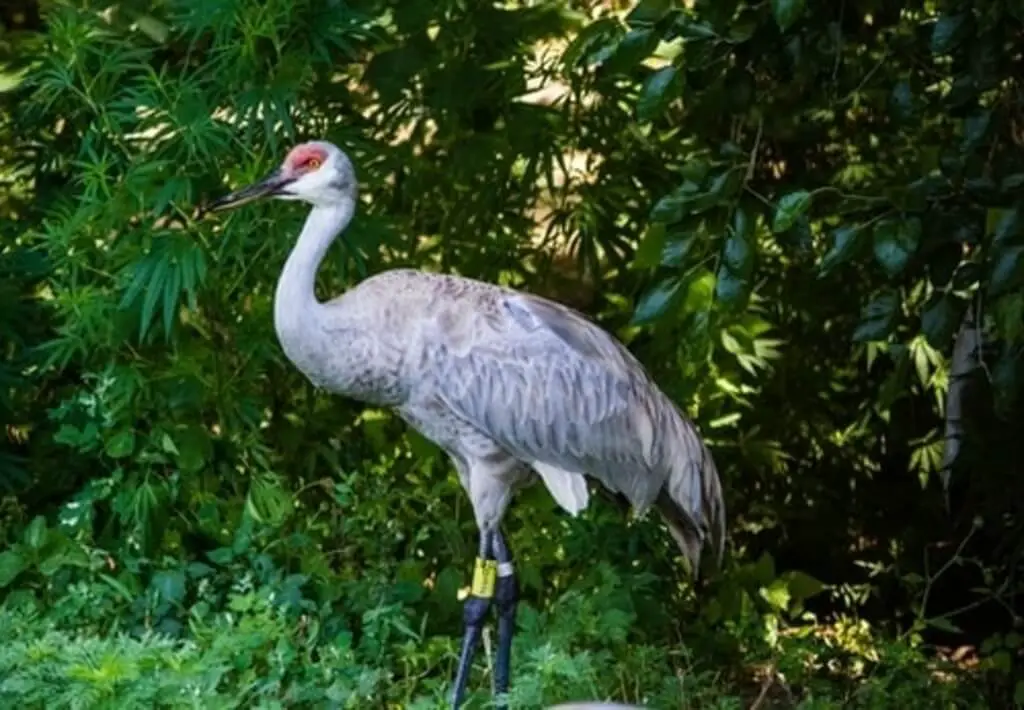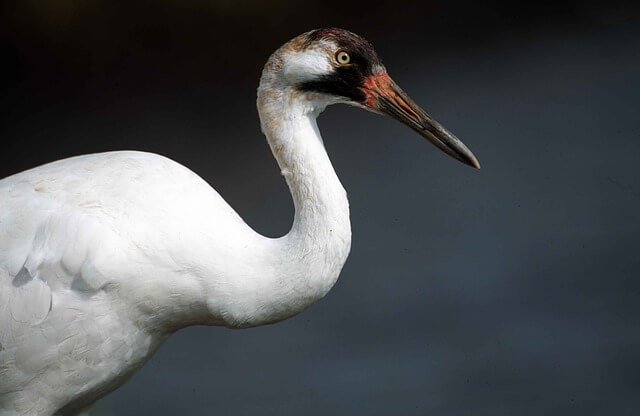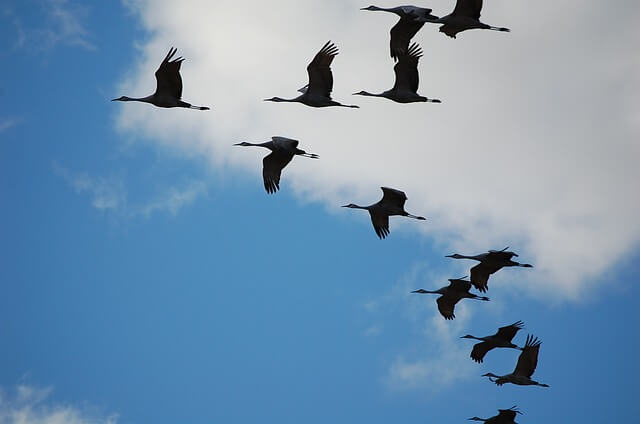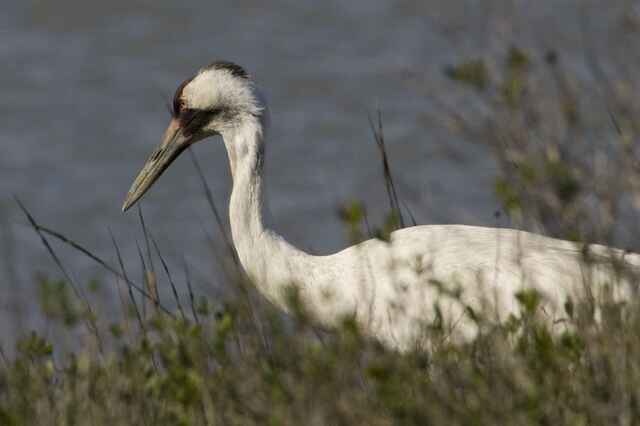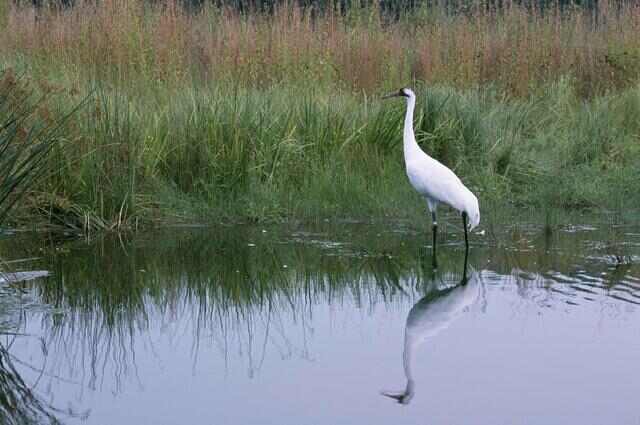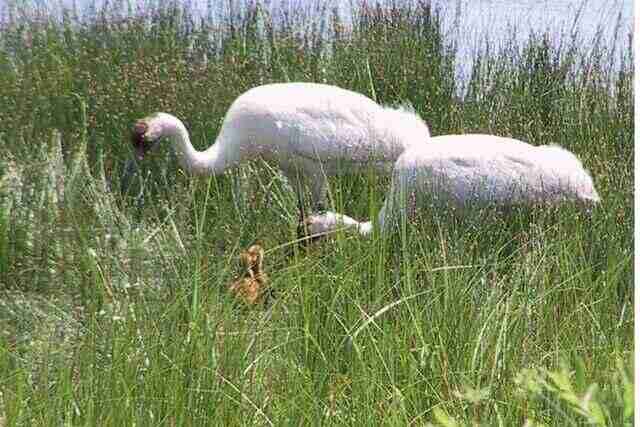Dive into the captivating world of Whooping Cranes, an iconic North American crane species. In this article, we’ll unveil 50 interesting facts about Whooping Cranes, complete with captivating photos, identification tips, and in-depth information, providing you with a comprehensive insight into the extraordinary lives of these avian wonders!
Whooping Crane (Overview)
| Identification | Bright white plumage, large red head patch, black wing tips, yellow eyes, thin black legs with black joints, long dark pointed bill with a wide gape. |
|---|---|
| Size | Length: 5.0 feet (60.0 in), Weight: 13.1-17.2 lbs. (210-275 oz.), Wingspan: 7.0-8.0 feet (84.0-96.0 in) |
| Taxonomy | Order: Gruiformes, Family: Gruidae, Genus: Grus, Species: G. Americana, Scientific Name: Grus Americana |
| Lifespan | 30 years in the wild, up to 40 years in captivity |
| Range | Canada, USA, and Northern Mexico, coastal and inland waterways of Canada, Alaska, Minnesota, Texas, and Louisiana |
| Migration | Breeding in northern wetlands, wintering in Texas or North Mexico |
| Habitat | Lakes, bogs, prairies, wet meadows, wetlands, swamps, freshwater marshes, agricultural fields, grasslands, and savannas |
| Diet | Fish (75%), insects (10%), amphibians (5%), other aquatic invertebrates, and a small amount of grains |
| Population | Estimated 800 individuals (Population Increasing, Listed Endangered Species) |
| Breeding | April to early May, 1-3 olive-colored eggs with brown spots |
| Fledgling Period | 9 to 10 months |
| Nesting Habitat | Wetlands near dense cattails or tall grasses |
| Nesting Materials | Sticks, branches, twigs, cattails, moss, cup-shaped ground nest |
| Mating Season | April to early May |
| Incubation | Approximately 29–31 days, both adults incubate |
| Chick Care | Mother feeds chick for about 1 month, chicks fly at 11-13 weeks, leave nest at 10 months |
1. Iconic Plumage: Whooping Cranes Are Known for Their White Feathers
Whooping Cranes are renowned for their extraordinary all-white plumage, which presents a truly breathtaking sight in the wild. This pristine white feathering serves as a captivating canvas that splendidly contrasts with their striking jet-black wingtips and the distinctive, contrasting facial markings, creating a visually arresting spectacle that leaves observers in awe of their ethereal beauty and grace.
2. Mating for Life: Whooping Cranes Form Lifelong Pair Bonds
These cranes are celebrated for their profound commitment to one another, a testament to their deep emotional bonds. They frequently form enduring monogamous relationships that persist throughout their impressively long lifespans, which can extend up to an impressive 25 years.
3. Elusive Population: Only Around 800 Whooping Cranes Exist in the Wild
The Whooping Crane population teeters on the brink of extinction, existing in a state of precarious vulnerability. Today, a mere fraction of their historic numbers persists, with an estimated count of only around 800 individuals inhabiting their natural habitats. This harrowing decline underscores the urgency of conservation efforts required to safeguard their future existence and reverse the alarming trajectory toward extinction.
4. Wing Span Wonder: They Have One of North America’s Largest Wingspans
Their grandeur extends beyond their pristine plumage, encompassing their majestic wingspan, which can stretch up to an awe-inspiring 7.5 feet. This wingspan not only accentuates their remarkable physical presence but also firmly establishes them as one of North America’s most sizable bird species.
5. Courtship Dance: Whooping Cranes Engage in Elaborate Mating Rituals
During their enchanting courtship rituals, Whooping Cranes engage in elaborate and highly choreographed dances that are a testament to their grace and dedication to the art of successful reproduction. These dances involve graceful leaps, elegant bows, and resonant calls, executed with precision to impress potential mates.
6. Distinctive Call: Whooping Cranes Get Their Name from Their Vocalization
The iconic “whooping” call, which gives these majestic birds their name, is a resounding and unmistakable vocalization that reverberates throughout their habitats. This distinctive vocalization serves as a powerful tool for communication, enabling them to convey messages to fellow cranes and reaffirm their presence. Beyond its role in communication, the resonant “whoop” also serves as a formidable means of establishing territorial boundaries.
7. Ancient Species: Whooping Cranes Are Among the Oldest Bird Species
These magnificent cranes serve as living testimonials to avian longevity, bearing witness to the remarkable endurance of their species. They proudly belong to one of the planet’s most ancient bird lineages, boasting a heritage that spans an astonishing 2 million years into the Earth’s past.
8. Slow Reproduction: They Produce Few Chicks Each Year
Whooping Cranes encounter the formidable challenge of slow reproduction, a process characterized by the production of just one or two chicks per nesting season. This limited reproductive rate significantly contributes to their vulnerability and precarious conservation status, as it makes population recovery a protracted and delicate endeavor, intensifying the importance of meticulous conservation efforts to safeguard their future existence.
9. Critical Wintering Grounds: They Migrate to Texas for the Winter
Whooping Cranes embark on a truly arduous and awe-inspiring migratory journey, covering thousands of miles as they depart from their northern breeding grounds. Their determined flight leads them to the critical wintering habitats along the picturesque Texas coast, where they seek refuge from the unforgiving grasp of harsh winters.
10. A Varied Diet: Whooping Cranes Are Omnivorous Eaters
In their pursuit of a well-rounded diet, Whooping Cranes exhibit an omnivorous nature, displaying remarkable versatility in their feeding habits. They consume a diverse array of sustenance, including aquatic invertebrates plucked with precision from waterways, small fish deftly snatched from beneath the surface, and a variety of plants carefully selected from their surroundings. This adaptability allows them to seamlessly adjust their dietary preferences in response to shifting seasons and the ever-changing availability of resources
11. Stately Stature: They Stand Tall Among North American Birds
Notably, Whooping Cranes don’t just possess an impressive wingspan; they also exhibit an imposing stature on their long, graceful legs, standing at an average height of approximately 5 feet. This commanding presence they exude amidst their wetland habitats is a testament to their statuesque elegance, making them an unmistakable and awe-inspiring presence in these ecosystems.
12. Survival Challenges: Habitat Loss and Human Activity Threaten Them
The survival of Whooping Cranes faces ongoing threats, including habitat loss due to human development, collisions with power lines, and disruptions caused by recreational activities. This highlights the urgent need for conservation efforts to protect these endangered birds and their habitats.
13. Conservation Heroes: Dedicated Efforts to Save Them
Numerous conservation organizations, scientists, and volunteers tirelessly work to protect and restore Whooping Crane populations, embodying the hope and determination to ensure their continued existence.
14. Great Migrators: They Undertake One of the Longest Migrations in North America
Their remarkable migratory journey stands as a testament to their endurance, with Whooping Cranes embarking on one of North America’s lengthiest migrations, covering vast distances of thousands of miles between their breeding and wintering grounds.
15. Fragile Chicks: Young Whooping Cranes Are Vulnerable
Whooping Crane chicks are exceptionally vulnerable during their early days, confronting a host of challenges that include the constant threat of predators, the unpredictability of adverse weather conditions, and the disruptive impact of human disturbances.
16. Silent First Year: Young Cranes Remain Mute During Their First Year
During their inaugural year of life, juvenile Whooping Cranes typically remain predominantly silent, primarily relying on non-verbal communication through intricate body language and subtle gestures to interact with their parents and peers.
17. Signature Red Crowns: Adults Display a Distinctive Red Patch on Their Heads
Adult Whooping Cranes are notable for a striking and unmistakable feature: their vibrant red crowns. This prominent field mark serves as a clear visual distinction between adults and juvenile cranes, making it easier to identify these majestic birds in the wild.
18. Global Responsibility: International Cooperation for Their Conservation
Conservation efforts for Whooping Cranes transcend national boundaries. The vital protection of these majestic birds relies on robust international collaboration between the United States and Canada, recognizing the significance of shared responsibility for their survival.
19. Lifelong Learning: Juvenile Cranes Learn to Migrate From Older Cranes
Young Whooping Cranes depend on their seasoned counterparts, drawing upon the wisdom of older, experienced cranes to impart vital knowledge, including the intricacies of migratory routes, navigation skills, and crucial survival techniques.
20. First Flight: Chicks Fledge at Around Two Months Old
At around two months of age, Whooping Crane chicks reach a significant developmental milestone by taking their inaugural flight, an event that marks the beginning of their journey towards independence and adulthood.
21. Hidden Nests: Parents Conceal Nests to Protect Eggs
In an effort to safeguard their eggs from potential threats, adult Whooping Cranes exhibit remarkable caution by meticulously concealing their nests within the thick vegetation of their wetland habitats.
22. Slow Growth: Whooping Cranes Mature Gradually
These cranes undergo a process of gradual growth and maturation, during which their distinctive white plumage gradually develops and becomes more prominent over time.
23. Epic Migration Tale: A Journey Through Multiple U.S. States
Their migration route spans across several U.S. states, encompassing vast distances that include states such as North Dakota, Nebraska, and Oklahoma, exemplifying the incredible territory they traverse during their journey.
24. Unique Wetland Ecosystems: Whooping Cranes Serve as Indicator Species
The presence of Whooping Cranes in wetland ecosystems serves as a valuable indicator of the overall environmental health of these critical habitats, underscoring the utmost significance of preserving and safeguarding these vital ecosystems.
25. Vocal Vocabulary: They Communicate Through Various Calls
Beyond their iconic whooping call, Whooping Cranes exhibit a diverse repertoire of vocalizations, each meticulously tailored to serve specific purposes ranging from alerting fellow cranes to intricate courtship rituals.
26. Remote Nesting: Breeding Sites Are Often in Wilderness
Their choice of breeding grounds frequently leads them to remote and pristine wilderness areas, offering crucial seclusion and tranquility that is essential for their nesting and the rearing of their chicks.
27. Dedicated Researchers: Scientists Study Their Behavior and Migration Patterns
Devoted researchers play a crucial role in safeguarding Whooping Cranes. They meticulously monitor these magnificent birds, observing their behavior, tracking their migration patterns, and assessing nesting success.
28. Hope for the Future: Whooping Cranes Symbolize Conservation Triumph
Despite the daunting challenges they confront, Whooping Cranes serve as beacons of hope, symbolizing the potential for conservation success. They inspire and fuel ongoing, determined efforts to ensure their future survival and safeguard their remarkable legacy for generations to come.
29. V-Shaped Migration: They Fly in Formation During Migration
While migrating, Whooping Cranes often form the distinctive V-shaped flight pattern commonly associated with migratory birds.
30. Southwestern Population: There’s a Non-Migratory Population in Louisiana
A small non-migratory population of Whooping Cranes can be found in southwestern Louisiana, demonstrating adaptability to different environments.
31. Spring Return: They Start Migrating North in Late February
In late February and early March, Whooping Cranes begin their journey northward to their breeding grounds as a sign of the impending spring season.
32. Remote Nesting Sites: Nests Are Often in Dense Marshes
Whooping Crane nests are meticulously hidden within dense marsh vegetation, providing both camouflage and protection for their eggs and chicks.
33. Thermal Regulation: They Fluff Their Feathers to Regulate Temperature
Whooping Cranes engage in feather fluffing, a behavior that helps them regulate their body temperature, especially during cold weather.
34. Late Maturity: They Reach Sexual Maturity at Around Three to Five Years Old
Whooping Cranes are relatively late bloomers in terms of reproductive maturity, often not breeding until they are three to five years old.
35. Largest Threat to Chicks: Predation by Native Birds
While predators like raccoons and bobcats pose threats to Whooping Crane chicks, they also face the unexpected risk of predation by native bird species such as American Crows and Great Horned Owls.
36. Social Foragers: They Often Feed Together in Groups
Whooping Cranes frequently engage in social foraging, where multiple cranes search for food together, benefiting from safety in numbers.
39. Older Siblings Assist: Juvenile Cranes Help Care for Younger Chicks
In some instances, older juvenile cranes from previous years’ broods will assist in raising and protecting the newly hatched chicks.
40. Supplementary Feeding: Conservationists Provide Extra Food for Chicks
To boost chick survival rates, conservationists sometimes supplement the natural diet of Whooping Crane chicks with extra food, ensuring they receive adequate nutrition.
41. Synchronized Migrations: Juveniles Follow Older Cranes to Learn Routes
Young Whooping Cranes learn migration routes by following older, experienced cranes, creating synchronized and cohesive migratory movements.

